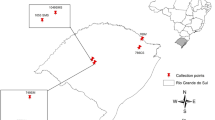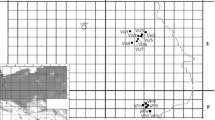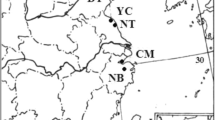Abstract
Alyssum lesbiacum is a well-established Ni hyperaccumulator, endemic to serpentine soils of Lesbos Island (Greece). A total of 95 individuals were collected from 17 plots encompassing the only four large populations of this species. ISSR (Inter-simple sequence repeat) markers were used to assess genetic diversity and population structure of A. lesbiacum to provide initial guidance for the development of successful management and conservation measures. A total of ten primers produced 82 bands, 96.34 % being polymorphic. The largest part of total diversity was found within populations, rather than among them. AMOVA analysis partitioned the largest part of diversity within plots (66 %), while 15 % contained among plots within populations and 19 % among populations. Principal coordinates analysis along with dendrogram based on genetic distances among populations showed a high degree of genetic differentiation of the isolated population Loutra. At a smaller scale, distance was not the most significant factor influencing the patterns of genetic diversity, but topography, ecosystem types and connectivity through streams. According to our results, conservation efforts should be organized at the level of watersheds and ecosystem types, considering them as management units. For ex situ conservation and restoration, seed samplings should be representative of the different habitats and watersheds as well as the patches of large and small populations while keeping the east population of Loutra separate from the other three central populations, to avoid any loss of genetic diversity and to preserve the character of the local adapted populations.





Similar content being viewed by others
References
Adamidis GC, Kazakou E, Baker AJM, Reeves RD, Dimitrakopulos PG (2013) The effect of harsh abiotic conditions on the diversity of serpentine plant communities on Lesbos, an eastern Mediterranean Island. Plant Ecol Divers. doi:10.1080/17550874.2013.802050
Adamidis GC, Aloupi M, Kazakou E, Dimitrakopulos PG (2014) Intra-specific variation in Ni tolerance, accumulation and translocation patterns in the Ni-hyperaccumulator Alyssum lesbiacum. Chemosphere 95:496–502
Anacker BL (2011) Phylogenetic patterns of endemism and diversity. In: Harrison SP, Rajakaruna N (eds) Serpentine: the evolution and ecology of a model system. University of California Press, Berkeley, pp 49–70
Baker AJM, Proctor J, Reeves RD (1992) The vegetation of ultramafic (serpentine) soils. Intercept, Andover
Barrett SCH, Eckert CG, Husband BC (1993) Evolutionary processes in aquatic plant populations. Aquat Bot 44:105–145
Bhargava A, Carmona FF, Bhargava M, Srivastava S (2012) Approaches for enhanced phytoextraction of heavy metals. J Environ Manage 105:103–120
Brady KU, Kruckeberg AR, Bradshaw HD (2005) Evolutionary ecology of plant adaptation to serpentine soils. Annu Rev Ecol Evol Systemat 36:243–266
Brooks RR (1987) Serpentine and its vegetation: a multidisciplinary approach. Dioscorides Press, Portland
Brooks RR, Morrison RS, Reeves RD, Dudley TR, Akmans Y (1979) Hyperaccumulation of nickel by Alyssum Linnaeus (Cruciferae). P Roy Soc Lond B 203:387–403
Carré G, Roche P, Chifflet R, Morison N, Bommarco R, Harrison-Cripps J, Krewenka K, Potts SG, Roberts SPM, Rodet G, Settele J, Steffan-Dewenter I, Szentgyörgyi H, Tscheulin T, Westphal C, Woyciechowski M, Vaissière BE (2009) Landscape context and habitat type as drivers of bee diversity in European annual crops. Agric Ecosyst Environ 133:40–47
Chaney RL, Angle JS, McIntosh MS, Reeves RD, Li YM, Brewer EP, Chen KY, Roseberg RJ, Perner H, Synkowski EC et al (2005) Using hyperaccumulator plants to phytoextract soil Ni and Cd. Z Naturforsch 60:190–198
Chaney RL, Angle JS, Broadhurst CL, Peters CA, Tappero RV, Sparks DL (2007) Improved understanding of hyperaccumulation yields commercial phytoextraction and phytomining technologies. J Environ Qual 36:1429–1443
Coleman RG, Jove C (1992) Geological origin of serpentinites. In: Baker AJM, Proctor J, Reeves RD (eds) The vegetation of ultramafic (serpentine) soils. Intercept, Andover, pp 1–17
Courbot M, Willems G, Motte P, Arvidsson S, Roosens N, Saumitou-Laprade P, Verbruggen N (2007) A major quantitative trait locus for cadmium tolerance in Arabidopsis halleri colocalizes with HMA4, a gene encoding a heavy metal ATPase. Plant Physiol 104:1052–1065
Culley TM, Wolfe AD (2001) Population genetic structure of the cleistogamous plant species Viola pubescens Aiton (Violaceae), as indicated by allozyme and ISSR molecular markers. Heredity 86:545–556
Felsenstein J (1985) Confidence limits on phylogenies: an approach using the bootstrap. Evolution 39:783–791
Gambi OV (1992) The distribution and ecology of the vegetation of ultramafic soils in Italy. In: Roberts BA, Proctor J (eds) The ecology of areas with serpentinized rocks-a world view. Kluwer Academic Publishers, Dordrecht, pp 217–247
Garcıa-Barriuso M, Fernandez-Castellano C, Rocha J, Bernardos S, Amich F (2012) Conservation study of endemic plants in serpentine landscapes: Antirrhinum rothmaleri (Plantaginaceae), a serpentinophyte with a restricted geographic distribution. Plant Biosyst 146(2):291–301
Guillot G, Santos F (2010) Using AFLP markers and the Geneland program for the inference of population genetic structure. Mol Ecol Resour 10(6):1082–1084
Guillot G, Estoup A, Mortier F, Cosson JF (2005) A spatial statistical model for landscape genetics. Genetics 170(3):1261–1280
Hanikenne M, Talke IN, Haydon MJ, Lanz C, Nolte A, Motte P, Kroyman J, Weigel D, Krämer U (2008) Evolution of metal hyperaccumulation required cis-regulatory changes and triplication of HMA4. Nature 453:391–395
Harrison S, Rajarkaruna N (2011) Serpentine: the evolution and ecology of a model system. University of California Press, Berkeley
Heywood VH, Iriondo JM (2003) Plant conservation: old problems, new perspectives. Biol Conserv 113:321–335
Huff DR, Peakall R, Smouse PE (1993) RAPD variation within and among natural populations of outcrossing buffalograss Buchloe dactyloides (Nutt) Engelm. Theor Appl Genet 86:927–934
Jenny H (1980) The soil resource: origin and behavior. Ecological studies, 37th edn. Springer-Verlag, New York, pp 256–259
Kazakou E, Dimitrakopoulos PG, Baker AJM, Reeves RD, Troumbis AY (2008) Hypotheses, mechanisms and trade-offs of tolerance and adaptation to serpentine soils: from species to ecosystem level. Biol Rev 83:495–508
Kazakou E, Adamidis GC, Baker AJM, Reeves RD, Godino M, Dimitrakopoulos PG (2010) Species adaptation in serpentine soils in Lesbos Island (Greece): metal hyperaccumulation and tolerance. Plant Soil 332:369–385
Kruckeberg AR (1985) California serpentines: flora, vegetation, geology, soils, and management problems Berkeley. University of California
Kruckeberg AR (2002) Geology and plant life: The effects of landforms and rock type on plants. WA Univ: Washington Pressm, Seattle
Kruckeberg AR (2004) The status of conservation of serpentinite sites in North America. Intern Geol Rev 46:857–860
Lefèbvre C, Vernet P (1990) Microevolutionary processes on contaminated deposits. In: Shaw AJ (ed) Heavy metal tolerance in plants: evolutionary aspects. CRC Press Inc, Boca Raton, pp 286–297
Linhart YB, Grant MC (1996) Evolutionary significance of local genetic differentiation in plants. Annu Rev Eco Syst 27:237–277
Mayer MS, Soltis PS, Soltis DE (1994) The evolution of the Streptanthus glandulosus complex (Cruciferae): genetic divergence and gene flow in serpentine endemics. Am J Botany 81:1288–1299
McConkey KR, Prasad S, Corlett RT, Campos-Arceiz A, Brodie JF, Rogers H, Santamaria L (2012) Seed dispersal in changing landscapes. Biol Conserv 146:1–13
Mengoni A, Gonnelli C, Brocchini E et al (2003) Chloroplast genetic diversity and biogeography in the serpentine endemic Ni-hyperaccumulator Alyssum bertolonii. New Phytol 157:349–356
Miller MP (1997) Tools for Population Genetic Analysis. Version 1.3. Computer software distributed by the author. Department of Biological Sciences, Northern Arizona University, Flagstaff
Montalvo AM, Ellstrand LC (2000) Transplantation of the subshrub Lotus scoparius: testing the home-site advantage hypothesis. Conserv Biol 14:1034–1045
Navarro T, El Oualidi J, Taleb MS, Pascual V, Cabezudo B (2009) Dispersal traits and dispersal patterns in an Oro-Mediterranean thorn cushion plant formation of eastern High Atlas, Morocco. Flora 2004:658–672
Nei M (1973) Analysis of gene diversity in subdivided populations. Proc Natl Acad Sci 70:3321–3323
Nei M (1987) Molecular evolutionary genetics. Columbia University Press, New York
Nybom H (2004) Comparison of different nuclear DNA markers for estimating intraspecific genetic diversity in plants. Mol Ecol 13:1143–1155
Peakall R, Smouse PE (2012) GenAlEx 6.5: genetic analysis in Excel. Population genetic software for teaching and research-an update. Bioinformatics 28:2537–2539
Peakall R, Smouse PE, Huff DR (1995) Evolutionary implications of allozyme and RAPD variation in diploid populations of dioecious buffalograss Buchloe dactyloides. Mol Ecol 4:135–147
Pfeifer M, Jetschke G (2006) Influence of geographical isolation on genetic diversity of Himantoglossum hircinum (Orchidaceae). Folia Geobot 41:3–20
Pharmawati M, Yan G, Finnegan PM (2005) Molecular variation and fingerprinting of Leucadendron cultivars Proteaceae by ISSR markers. Ann Bot 95(7):1163–1170
Pollard AJ, Powell KD, Harper FA, Smith JAC (2002) The genetic basis of metal hyperaccumulation in plants. Crit Rev Plant Sci 21:539–566
Pollard AJ, Reeves RD, Baker AJM (2014) Facultative hyperaccumulation of heavy metals and metalloids. Plant Sci 217–218:8–17
Proctor J, Woodell SRJ (1975) The ecology of serpentine soils. Adv Ecol Res 9:255–366
Raymond M, Rousset F (1995) GENEPOP (Version 1.2), a population genetics software for exact tests and eucumenicism. J Hered 86:45–249
Reeves RD, Baker AJM, Kelepertsis A (1997) The distribution and biogeochemistry of some serpentine plants of Greece. In: Jaffré T, Reeves RD, Becquer T (eds) Ecologie des milieux sur roches ultramafiques et sur sols metallifères. ORSTOM, Nouméa, pp 205–207
Reeves RD, Baker AJM, Becquer T, Echevarria G, Miranda ZJG (2007) The flora and biogeochemistry of the ultramafic soils of Goiás state, Brazil. Plant Soil 293:107–119
Schleuning M, Becker T, Vadillo GP, Hahn T, Matthies D, Durka W (2011) River dynamics shape clonal diversity and genetic structure of an Amazonian understorey herb. J Ecol 99:373–382
Selvi F (2007) Diversity, geographic variation and conservation of the serpentine flora of Tuscany (Italy). Biodiv Conserv 16:1423–1439
Sokal R (1979) Testing statistical significance of geographic variation patterns. Syst Zool 28:227–232
Stevanovic V, Tan K, Iatrou G (2003) Distribution of the endemic Balkan flora on serpentine I.—obligate serpentine endemics. Plant Syst Evol 242:149–170
Strawn KE (2013) Unearthing the habitat of a hyperaccumulator: case study of the invasive plant yellowtuft (Alyssum; Brassicaceae) in Southwest Oregon, USA. Manag Biol Invasion 4(3):249–259
Strid A, Tan K (2002) Flora Hellenica, vol 2. A.R.G. Gantner Verlag KG, Ruggell
Tscheulin T, Neokosmidis L, Petanidou T, Settele J (2011) Impact of landscape context on the abundance and diversity of bees in Mediterranean olive groves. B Entomol Res 101:557–564
van der Ent A, Baker AJM, Reeves RD, Schat H, Pollard AJ (2013) Hyperaccumulators of metals and metalloid trace elements: facts and fiction. Plant Soil 362:319–334
Willems G, Dräger DB, Courbot M, Godé C, Verbruggen N, Saumitou-Laprade P (2007) The genetic basis of zinc tolerance in the metallophyte Arabidopsis halleri ssp. halleri (Brassicaceae): an analysis of quantitative trait loci. Genetics 176:659–674
Wolf AT, Howe RW, Hamrick JL (2000) Genetic diversity and population structure of the serpentine endemic Calystegia collina (Convolvulaceae) in Northern California. Am J Bot 87:1138–1146
Yeh FC, Yang RC, Boyle T (1999) POPGENE 32-version 1.31. Population Genetics Software. University of Alberta Edmonton, AB, Canada. http://www.ualberta.ca/~fyeh/popgene_download.html
Acknowledgments
This research has been co-financed by the European Union (European Social Fund—ESF) and Greek national funds through the Operational Program “Education and Lifelong Learning” of the National Strategic Reference Framework (NSRF)—Research Funding Program: Heracleitus II. Investing in knowledge society through the European Social Fund.
Author information
Authors and Affiliations
Corresponding author
Electronic supplementary material
Below is the link to the electronic supplementary material.
Supplementary material 1
Map of Lesbos Island (Greece) showing the populations of Alyssum lesbiacum sampled in this study and the sampling plots of population Loutra (L1–L4) (TIFF 25487 kb)
Rights and permissions
About this article
Cite this article
Adamidis, G.C., Dimitrakopoulos, P.G., Manolis, A. et al. Genetic diversity and population structure of the serpentine endemic Ni hyperaccumulator Alyssum lesbiacum . Plant Syst Evol 300, 2051–2060 (2014). https://doi.org/10.1007/s00606-014-1047-3
Received:
Accepted:
Published:
Issue Date:
DOI: https://doi.org/10.1007/s00606-014-1047-3




